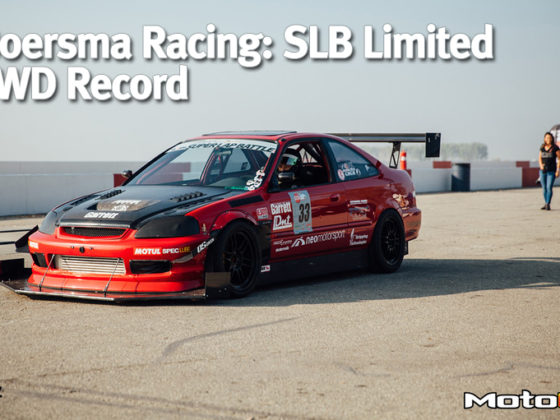,
 After a quick briefing with the Ron Fellows Race School instructor, I was ready to get on track.
After a quick briefing with the Ron Fellows Race School instructor, I was ready to get on track.
 All the Ron Fellows Race School instructors doing the lead-follow laps were in mildly prepped 6th Gen SS Camaros.
All the Ron Fellows Race School instructors doing the lead-follow laps were in mildly prepped 6th Gen SS Camaros.

Although there weren’t really any harsh braking zones on the section of the track that we were testing, the brakes seemed pretty efficient for the size of the car for the 1-2 laps of testing that we did per Camaro, especially considering that they are a factory brake pad and not a race pad. In fact, the Camaros that had the upgraded factory brake package were more efficient than a lot of aftermarket race pads that I have tried. For those that are curious, if I had to compare how the upgraded brakes felt to an aftermarket system, I would say that they felt like Project Mu Club Racer pads paired with an aftermarket 4-piston caliper big brake kit, minus all of the loud squeaks that the race brake pads make. In other words, I personally liked the upgraded brake package and would recommend it to someone purchasing a Camaro. I think it makes a great balance between street and track performance, it works well for the size of the car, and it is a must for the V8’s.
As mentioned before, the Camaro currently offers three engine options: the 4-cylinder turbo, the V6, and the V8. The 4-cylinder turbo may honestly catch you off-guard. It makes good power with 275 horsepower, but it has a surprisingly smooth power delivery for a turbo. The 295 lb.-ft. of torque feels really consistent throughout the power band. Yes, I said 295 lb.-ft of torque. Three things would make this engine option really exciting if they were available: a higher redline, tighter gearing, and a limited slip differential. The higher redline would just be for additional driver amusement, but I really think an option for tighter gearing would really help the 4-cylinder stay in its optimal power band and make the whole car feel like it’s as lightning quick as it truly is. I just really wish a limited slip differential was available for the 4-cylinder- it could really be the ultimate underdog track toy to its big brother, the V8 SS.
The V6 is a 60 horsepower gain but an 11 lb.-ft. torque loss from the 4-cylinder turbo option. I personally think this engine option should also have a turbo. If you’re going to add the additional and noticeable nose weight from a V6, you might as well have a significant power and torque jump. I’m sure that Chevrolet has specific reasons to have the V6 option based on market research, but as it currently sits, I would recommend getting the 4-cylinder turbo instead- if you are buying a Camaro but still want to be somewhat conservative. If you are searching for naturally aspirated power, just go all the way and get the V8- the V6 doesn’t really feel that much faster than the 4-cylinder turbo. The benefit that the V6 does have over the 4-cylinder option is that you can opt for the 1LE V6 track package that has a limited slip differential. That’s a story for a different day, however. We did not test anything 1LE, unfortunately, at this event.
The V8 option is where Chevrolet is right on the money- just pure, American V8. It’s true to the Camaro’s roots and muscle car representation. It’s probably the smoothest feeling V8 I have ever driven- it doesn’t feel like you’re going that fast until you look down and see the speedometer. Remember, it does have 455 horsepower and 455 lb.-ft. torque. Tread carefully! Or, should I say, be cognizant of brake zones and enjoy the power.
I honestly don’t even remember the base model V8- if you’re going this route, do yourself a favor and just save up the extra cash to get the intake and exhaust packages. I can’t imagine someone wanting a V8 Camaro and not wanting to hear it roar at least a little bit. You won’t regret it and will thank me later for the advice. You’re welcome!
Two things that I wished that the V8 test vehicles had were tighter gearing and a limited slip differential. However, there is good news! You can opt for both on the SS V8’s. I’m curious to see how the two options would feel in comparison in a track setting to the Camaros that we drove.
The most important aspect of a car, to me personally with a road course racing background, is the handling behavior. This is where I get really picky as a driver, as Clint Boisdeau knows all too well- he has spent the whole year working together with me to dial in my racecar to get the handling just perfect within a specific race class ruleset, even though small changes are made per racetrack. However, the reason why I am so picky on this topic and the reason why people like Clint and Mike Kojima have spent years and so many hours engineering in this category, is because races are won and lost over chassis tuning. Even the best drivers can be mid-pack or seconds off pace if they don’t have their cars handling how they should be. The teams at the top understand this concept, which contributes to their success.
Chevrolet has put a lot of time and effort into their engineering models to calculate the spring rates, suspension damping, suspension travel, and a new sway bar package for the Camaros fitted with their upgraded suspension package and newly announced, upgraded handling package. The handling package has larger sway bars to complement the suspension upgrade package, which allows the Camaro to be slightly lowered. Both packages should be purchased together to maintain a balance that the Camaro’s suspension engineers intended it to have.
The idea of the track test was to feel the difference between a base model and one with the suspension and handling packages. I think that the upgraded packages are a decent starting point and suit the 4-cylinder turbo Camaro well. From a track driving standpoint, it seems that additional tuning may be necessary to support the additional nose weight for the V8 Camaros and to correct some bump steer and travel issues when encountering imperfect surfaces.
Considering the nature of the event, it is totally understandable that the testing was done with traction control on. I am curious to see how the Camaro behaves when traction control does not interfere.
Any slight body roll, which is common for production cars, will trigger my motion sickness which is then hard to shake once taken into effect. Due to this, I had to sit out of the last activity, which was auto-crossing the new Cruze hatch. Clint doesn’t struggle with this issue however, so I therefore based the Cruze driving review on his input rather than my own.



